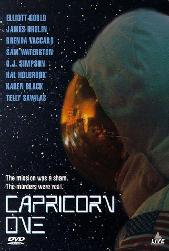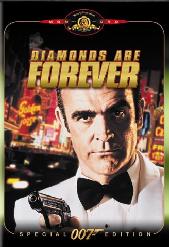movies







|
 ARTISAN ENTERTAINMENT |
 The 1978 movie
Capricorn One proved just how plausible a falsified NASA
mission is.
The 1978 movie
Capricorn One proved just how plausible a falsified NASA
mission is.
A Hollywood film can do lots of things because the writer controls all the characters. He just writes that the people in the film are fooled by the hoax, and the actors playing those people pretend to be fooled. It's that easy. It's fiction, not a documentary.
Although writer/director Peter Hyams touches on a few techniques that could be used to perpetrate a hoax, he doesn't fully explore what would be necessary in the real world. He doesn't have to. He's telling a story. He only has to fool characters that he controls. For example, the astronauts' voices from the spacecraft are being falsified by recordings made during simulations. This would work only until someone asked a question that wasn't covered during simulations. It's practical enough to achieve willful suspension of disbelief for the film's sake, but not practical enough to use in real life over and over again.
The Capricorn One scenario works because it's a hoax perpetrated in an environment invented and controlled by Hyams.
 The Mars surface footage
in Capricorn One looks suspiciously like the lunar surface
footage from NASA.
The Mars surface footage
in Capricorn One looks suspiciously like the lunar surface
footage from NASA.
This is probably because Hyams had several hours of Apollo video footage as a reference. It doesn't make the Apollo footage any less credible or Hyams' any more credible.
 WARNER HOME VIDEO |
 Stanley Kubrick's
masterpiece 2001: A Space Odyssey showed that convincing
special effects were possible in 1968, and that accurate depictions of
space travel could be produced on movie soundstages.
Stanley Kubrick's
masterpiece 2001: A Space Odyssey showed that convincing
special effects were possible in 1968, and that accurate depictions of
space travel could be produced on movie soundstages.
It's up to individual preference whether to believe the effects in 2001 were credible and accurate. We don't believe they were actually created in outer space. Here's where the cat gets let out of the bag:
- There are too many goofs. In several scenes we can see evidence that this is a manufactured film. We can see the edges of scenery panels, fly wires, reflections of equipment, rear projections, etc. These imperfections appear in every feature film despite efforts from filmmakers. Kubrick had several months and a large budget to orchestrate what would eventually be only two and a half hours of final product, and there were still errors. The Apollo program produced ten times that much footage with no editing seams and with no obvious mistakes.
- The astronomy is wrong. The views from earth to the moon, and of the earth from the lunar surface don't match. For example, the earth is high in the lunar sky as seen from Clavius; it should be low on the horizon. The phase of the earth changes radically between scenes.
- The photography is wrong. As in every space movie, we see a moving starfield in all the space scenes in 2001, along with sunlit objects. You cannot photograph both with the same camera settings. And even if you had a magical camera that could do it, the starfield shouldn't move. The cinematic reason for the moving starfield is to provide a background against which the motion of the foreground can be reckoned; filmmakers acknowledge it doesn't really happen that way, but it needs to happen in a movie.
- The propulsion is wrong. As Dr. Floyd's lunar transport lands, the dust billows as it would in an atmosphere, because it was filmed in an atmosphere. The dust would displace in a vacuum, but it would tend to form a flat sheet and would disperse quickly. When Dave Bowman blows the emergency hatch on the pod in order to re-enter the airlock, the pod stays right there. It should have been propelled away from the ship by the force of the escaping air.
- The zero-gravity scenes are wrong. As Dr. Floyd ascends to
orbit he sips through a straw, and the fluid level drops back down to
the container when he lets go. Sure, it could be a vacuum effect, but
it's not the way drinking happens currently in zero gravity. In
several scenes you can see supposedly weightless people moving as if
there were gravity -- "grip soles" notwithstanding:
- The Pan-Am captain hunches over Dr. Floyd's seat as a man in normal gravity would have done in order to rest his body weight on the seat back. Such a "hunker" is intuitive in gravity, but uncomfortable and unnatural in weightlessness.
- Dr. Floyd's tray rises up from his lap -- presumably because Dr. Floyd has forgotten to secure it. What made it spontaneously start floating upward? Why did it sway from side to side? And why did it stop floating upward for no visible reason a split-second before Dr. Floyd grabs it? Newton screams "fraud!" at this sort of cinematic license.
- The low-gravity scenes are wrong. The space station floor curves upward correctly to indicate the inside of a torus that spins to provide artificial gravity. But as the characters move about the scene they remain vertical with respect to the frame. They should instead tilt perpendicular to the angle of the floor where they are standing. There are numerous scenes that supposedly take place on the lunar surface, but no evidence of lesser gravity can be seen. The characters move as they would have on earth.
- The lunar landscape is wrong. Kubrick shows us sharp-pointed mountains even though high-definition close-range photographs from Lunar Orbiter 2 (1966) showed the rounded mountains familiar in Apollo photographs.
Again conspiracists claim to be able to identify obscure and minute anomalies in Apollo photos and video, but they can't seem to do it with their own evidence. Nevertheless the important point is the conspiracist argument that NASA could do it because Kubrick could do it. As we've seen, Kubrick can't do it. He can't establish and maintain a truly credible "hoax" for two hours. Nor are the special effects convincing enough to fool observant people into actually thinking they represent space or lunar environments.
 But there's actual
evidence -- historical accounts -- that Kubrick worked with NASA to
fake the footage.
But there's actual
evidence -- historical accounts -- that Kubrick worked with NASA to
fake the footage.
Many conspiracists, led by Clyde Lewis, point to an article circling around the Internet which purports to describe in detail the process Kubrick used to fake the moon landings. But the article is obviously intended as a joke, as a careful reading reveals.
 Stanley Kubrick's and
Peter Hyams' budgets were very small compared to NASA's. With $40
billion and professional physicists on hand to correct mistakes, these
directors could have made the effects much more
convincing.
Stanley Kubrick's and
Peter Hyams' budgets were very small compared to NASA's. With $40
billion and professional physicists on hand to correct mistakes, these
directors could have made the effects much more
convincing.
If so then the supposed genius of 2001: A Space Odyssey and Kubrick are irrelevant. The argument was that Kubrick was such a brilliant filmmaker he could have made a convincing hoax. But if Kubrick would have needed expert advisors, then those advisors (not Kubrick) would have been the real geniuses behind it. The conspiracists are just back to speculating about what might be done with supposedly limitless resources. The demonstrable state of the art in 1968 -- compelling but not convincing -- doesn't really have much to do with that.
And it really didn't have much to do with budget. The problems in 2001: A Space Odyssey and Capricorn One had more to do with deciding what effects to attempt rather than attempting good ones and failing. Budget would have increased the quality of the effects, but not their faithfulness to real life. No matter how much money you spend making a realistic starfield, it doesn't compensate for the fact that you shouldn't see one -- much less a moving one. The glitches also deal with basic filmmaking techniques, something Kubrick should already have known, and physicists wouldn't necessarily be helpful.
Consider also Silent Running. Kubrick budgeted $10 million for 2001: A Space Odyssey, while Douglas Trumbull's Silent Running was shot for about a tenth the cost. Trumbull produced the visual effects for both films. Silent Running is less ambitious than Kubrick's masterpiece, but achieves a greater level of consistency and credibility. Increasing the budget does not automatically increase the quality and seamlessness of the final product.


